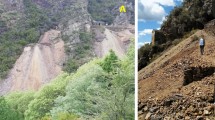Abstract
Mine tailings can provide a long-term source of environmental contamination. Lead-zinc mine tailings can represent a source of toxic elements-Pb and Zn through mobilization into surface water, and then into downstream rivers. Previous studies have shown that migration of heavy metals can be mitigated by carbonate rock. This research investigates the characterization of heavy metals and sulphur isotope in a downstream river of the Shanshulin Pb-Zn mine, which is located in Guizhou province in China, a typical carbonate area in the world. A slight alkalinity (pH > 8) of the river water is maintained owing to the carbonate rich country rocks. The results of this study show that heavy metals in water can be strongly adsorbed by suspended solids and therefore decrease more quickly than in sediments. Pb and Zn contents in water close to the waste pile are 6780 μg L-1 and 324 μg L-1 (Pb and Zn in water not affected by mine waste piles are only 3.71 μg L-1 and 11.6 μg L-1), respectively, meaning that the water is severely contaminated by the pile. Thirty kilometers downstream Pb and Zn contents in water drop quickly to 3.15 μg L-1 and 16.4 μg L-1. In contrast, Pb and Zn contents in sediment close to the waste pile are 4553 mg kg-1 and 7971 mg kg-1, respectively, and are still high 30 km downstream with measurements of 3334 mg kg-1 and 7268 mg kg-1 , respectively (Pb and Zn contents in sediment not affected by mine waste piles are only 20 mg kg-1 and 120 mg kg-1). This indicates that the impact of tailings on the sediment can be much further than on water. In sediment, Pb exists mostly as carbonate and oxide fractions, Zn mostly as sulfide+organic fraction, and Cu mostly as sulfide+organic, residual and carbonate fractions. Sulphur characteristics indicate that sulphur in sediment originates from mine tailing, soil and suspended solids in other tributaries, whereas sulphur in water originates from mine tailing dissolution, spring water, rain water and dissolution of gypsum. In conclusion, the environmental impact of mine tailing can be indicated by heavy metals content, sulphur content and sulphur isotope of sediment. On the other hand, heavy metal content, sulphur content or sulphur isotope of water are possibly not good indicators for mine impact due to mitigation of carbonate rocks, sorption of heavy metals, as well as interference of gypsum layers.
Similar content being viewed by others
References
Berger, A. C., Bethke, C. M. and Krumhanst, J. L.: 2000, ‘A process model of natural attenuation in drainage from a historic mining district’, Appl. Geochem. 15, 655–666.
Chen, S.: 1986, ‘Discussion of the genesis of lead-zinc deposits in West Guizhou Province and Northeast Yunnan Province’, Guizhou Geology, (3) (in Chinese).
Clevenger, T. E.: 1990, ‘Use of sequential extration to evaluate the heavy metals in mining eastes’, Water, Air, Soil Pollut. 50, 241–254.
Gray, N. F.: 1996, ‘Field assessment of acid mine drainage contamination in surface and groundwater’, Environ. Geol. 27(4), 358–361.
Han, G. and Liu, C.: 2000, ‘Hydrogeochemistry of Wujiang River Water in Guizhou Province’, Carsologica Sinica 19(1), 35–43 (in Chinese).
Holmstrom, H., Ljungberg, J. and Ohlander, B.: 1998, ‘Role of carbonate in mitigation of metal release from mining waste: evidence from humidity cells tests’, Environ. Geol. 37(4), 267–280.
Hong, Y., Zhu, Y., Zhang, H., Piao, H., Zeng, Y. and Liu, G.: 1993, ‘Sulphur isotope fractionation in coal burning and its environmental significance’, Acta Scientiae Circumstantiae, (2), 240–243 (in Chinese).
Hong, Y., Zhang, H., Zhu, Y., Piao, H., Jiang, H. and Liu, D.: 1994, ‘Sulphur isotope characteristic of rain water in China’, Progress in Natural Science 4(6), 741–745 (in Chinese).
Mao, J., Zhang, Q., Mao, D. and Gu, S.: 1998, Evolution of Shuicheng Detachment Fault Structure and Research of Lead-Zinc Deposits, Guizhou Press of Science and Technology, Guiyang (in Chinese).
Ohmoto, H. and Rye, R.O.: 1979, Geochemistry of Hydrothermal Ore Deposits, 2nd. ed.,Wiley, New York.
Ostlund, P., Torssander, P. and Morth, C. M. et al.: 1995, ‘Lead and Sulphur Isotope-Dilution During Dispersion from the Falun Mining Area’, J. Geochemical Exploration 52(1–2), 91–95.
Pain, D. J., Sanchez, A. and Meharg, A. A.: 1998, ‘The Donana ecological disaster: contamination of a world heritage estuarine marsh ecosystem with acidified pyrite mine waste’, Sci. Tot. Envir. 222(1–2), 45–54.
Stromberg, B. and Banwart, S.: 1999, ‘Experimental study of acidity-consuming processes in mining waste rock: some influences of mineralogy and particle size’, Appl. Geochem. 14, 1–16.
Taylor, B. E., Wheeler, M. C. and Nordstrom, D. K.: 1985, ‘Stable isotope geochemistry of acid mine drainage: experimental oxidation of pyrite’, Geochim. Cosmochim. Acta. 48, 2669–2678.
Tessier, A., Campbell, P. G. C. and Bisson, M.: 1979, ‘Sequential extration procedure for the speciation of particulate trace metals’, Anal. Chem. 51(7), 844–851.
Thode, H. G., Monster, J. and Dunford, H. B.: 1961, ‘Sulphur isotope geochemistry’, Geochim. Cosmochim. Acta. 25, 150–174.
Wan, G. et al.: 1995, Carbonates and Environment (Vol. 1). Seismo Press, Beijing (in Chinese).
Xu, Z.: 2002, ‘Water Geochemistry Research of Xijiang River Catchment’, Ph.D. Dissertation, Beijing Institute of Geology and Geophysics, Chinese Academy of Sciences, pp23 (in Chinese).
Yanagisawa, F. and Sakai, H.: 1983, ‘Thermal decomposition of barium sulfate-vanadium pentaoxide-silica glass mixtures for preparation of sulphur dioxide in sulphur isotope ratio measurements’, Anal. Chem. 55, 985–987.
Zhang, Q., Gu, S. and Mao, J.: 1999, ‘The ore deposit geochemistry of Qingshan lead-zinc deposit, Shuicheng, Guizhou’, Geol. Geochem. 27(1), 15–20 (in Chinese).
Author information
Authors and Affiliations
Corresponding author
Rights and permissions
About this article
Cite this article
Zhang, G., Liu, CQ., Yang, Y. et al. Characterization of Heavy Metals and Sulphur Isotope in Water and Sediments of a Mine-Tailing Area Rich in Carbonate. Water, Air, & Soil Pollution 155, 51–62 (2004). https://doi.org/10.1023/B:WATE.0000026517.71668.0b
Issue Date:
DOI: https://doi.org/10.1023/B:WATE.0000026517.71668.0b




